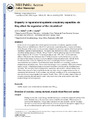Identificador persistente para citar o vincular este elemento:
https://accedacris.ulpgc.es/jspui/handle/10553/6543
| Título: | Disparity in regional and systemic circulatory capacities: do they affect the regulation of the circulation? | Autores/as: | Calbet, J. A.L. Joyner, M.J. |
Clasificación UNESCO: | 241106 Fisiología del ejercicio | Palabras clave: | Cardiac output Muscle VO2max |
Fecha de publicación: | 2010 | Publicación seriada: | Acta Physiologica | Resumen: | In this review we integrate ideas about regional and systemic circulatory capacities and the balance between skeletal muscle blood flow and cardiac output during heavy exercise in humans. In the first part of the review we discuss issues related to the pumping capacity of the heart and the vasodilator capacity of skeletal muscle. The issue is that skeletal muscle has a vast capacity to vasodilate during exercise [approximately 300 mL (100 g)(-1) min(-1)], but the pumping capacity of the human heart is limited to 20-25 L min(-1) in untrained subjects and approximately 35 L min(-1) in elite endurance athletes. This means that when more than 7-10 kg of muscle is active during heavy exercise, perfusion of the contracting muscles must be limited or mean arterial pressure will fall. In the second part of the review we emphasize that there is an interplay between sympathetic vasoconstriction and metabolic vasodilation that limits blood flow to contracting muscles to maintain mean arterial pressure. Vasoconstriction in larger vessels continues while constriction in smaller vessels is blunted permitting total muscle blood flow to be limited but distributed more optimally. This interplay between sympathetic constriction and metabolic dilation during heavy whole-body exercise is likely responsible for the very high levels of oxygen extraction seen in contracting skeletal muscle. It also explains why infusing vasodilators in the contracting muscles does not increase oxygen uptake in the muscle. Finally, when approximately 80% of cardiac output is directed towards contracting skeletal muscle modest vasoconstriction in the active muscles can evoke marked changes in arterial pressure. | URI: | https://accedacris.ulpgc.es/handle/10553/6543 | ISSN: | 1748-1708 | DOI: | 10.1111/j.1748-1716.2010.02125.x | Fuente: | Acta Physiologica [ISSN 1748-1708], v. 199, p. 393-406 |
| Colección: | Reseña |
Vista completa
Citas SCOPUSTM
52
actualizado el 08-jun-2025
Citas de WEB OF SCIENCETM
Citations
50
actualizado el 08-jun-2025
Visitas
55
actualizado el 16-dic-2023
Descargas
123
actualizado el 16-dic-2023
Google ScholarTM
Verifica
Altmetric
Comparte
Exporta metadatos
Este elemento está sujeto a una licencia Licencia Creative Commons

